- A HILLOCK WITH A TRADITION
Few are the privileged places where the elements of Nature, History and Tradition of the past and the present conjure up to make them famous. Pilar is such a hillock in Goa commanding a beautiful panoramic view all around, with the backdrop of the Arabian Sea and the Marmagoa harbour, a short distance away from the mouth of the serpentine river Zuari. This River meanders its way through lush green coconut groves, rice fields and salt pans extending all around, dotted with numerous hills, plains and plateaux as well as villages with Churches and temples elevating the soul to the Creator. The hillock is situated in the village of Goa-Velha, close to the old highway running from Panjim going south to Vasco and Margao. (The new bypass bifurcates the highway road, from Goa Velha to Agasaim Police Post, the old one going through Pilar and the new taking a different parallel direction). History too sheds its own lustre on this place. This hillock was part of the city of Govapuri, the erstwhile capital of Goa (before Old Goa and Panjim), from where the South Konkan Shilaharas (765-1020 AD) and the Kadambas (1050 -1354 AD) held sway over vast territories in Western India. It is situated 12 kilometres to the south of Panjim, the present capital of Goa, and lies on the roadway to the cities of Vasco and Margao.
- DYNASTIES THAT RULED GOA
For most Europeans and others, Goa is well known only as the erstwhile possession of the Portuguese in India. The Portuguese began to conquer Goa only from 1510 AD. Prior to that, from times immemorial, Goa was populated by various tribes and peoples and ruled by various dynasties, some local, some national and some from the neighbouring states of Maharashtra and Karnataka. Beginning with the Mauryas, the Satvahanas, Chutus, Kshatrapas, Abiras, Kalachuris, Bhojas, Kaikeyas, Konkan Mauryas, Guptas, Chalukyas of Badami, Sendrekas, Rashtrakuttas, Shilaharas, Kadambas, Hoysalas, Yadavas of Devagiri, Delhi Sultans, Nawabs of Honavar, Bahamani Sultans and Vijayanagar Rayas, and the Adil Shahs have held sway over parts of Goa or the whole of it, one after the other in succession, throughout the centuries.
- CULTURAL HERITAGE MUSEUM
Some of these important dynasties have left their mark on the Pilar hillock. Many artefacts of the past have been unearthed around Pilar and are preserved in the Pilar Seminary Museum. In this study, we will refer only to those of the above mentioned dynasties or periods, which have something to do with the hillock of Pilar, since we are dealing with the history of the place. However, since the Pilar hillock is situated in one of the first capitals of Goa, its history is deeply connected with the history of Goa. Secondly, the Museum has many artefacts that confirm the historical data found in copper plates and other inscriptions of some of the various rulers or the dynasties mentioned above.
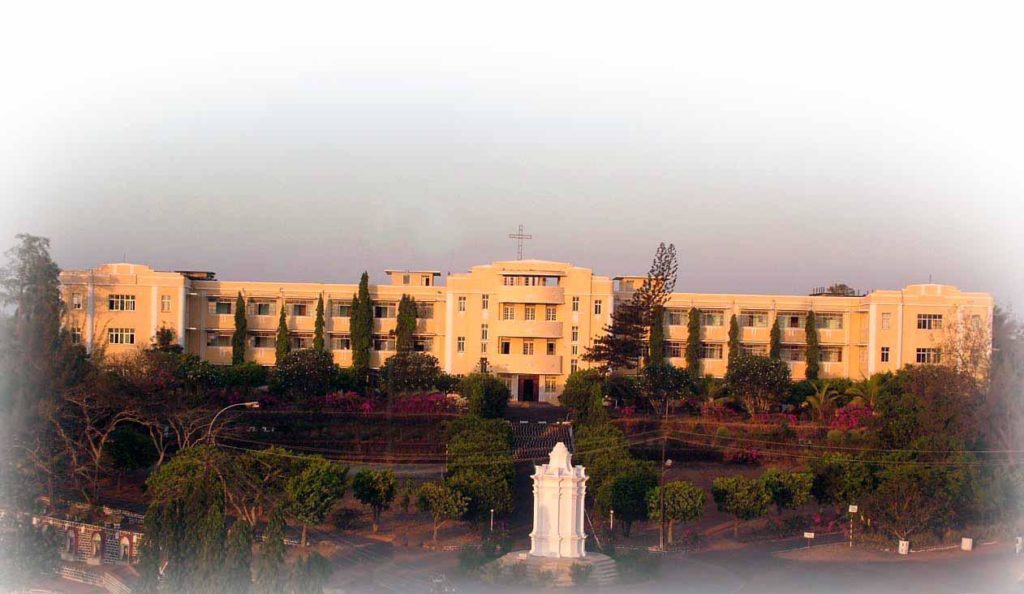
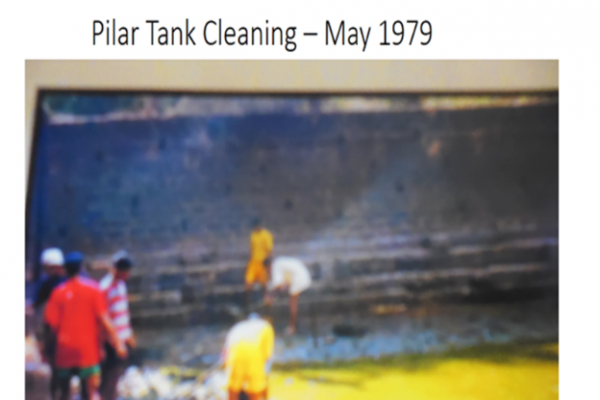
Most of these finds have been unearthed from the bottom of a centuries old tank after removing almost 18 feet (or 6 metres approximately) of deposits of silt and debris that had accumulated in it for centuries. The tank is situated within the compound belonging to the Seminary, at the bottom of the hillock, on the road going to Neura village, and was de-silted in 1979 to provide storage of water for the Seminary and other houses on the Pilar hillock.
Other artefacts are gathered from the surrounding areas in and around the Pilar hillock. These artefacts testify to the existence of the port of Govapuri, known as Gopakapattana, frequented by foreign ships from times immemorial1
- SEA SHORE AND COASTAL CAPITAL
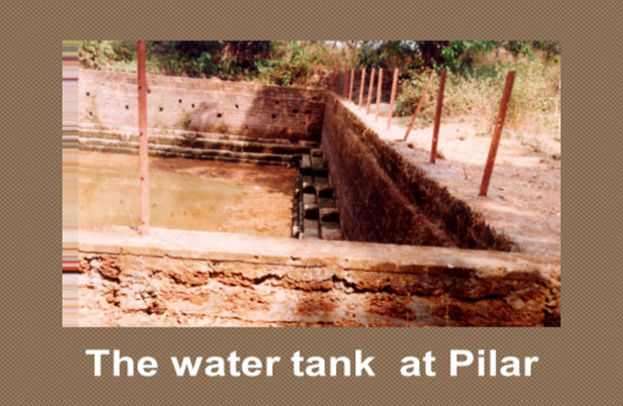
A half an hour walk from Pilar hillock leads one to a sea-shore. This shore of what is known as Goa-Velha village today, was the erstwhile Gopakapattana port2 of the city of Govapuri. This port was known to the seafarers from very ancient times. NIO scientists have recently deciphered that this port was 4500 years old, frequented by ships of different nations3 Gudea (2143-2134 BC), the ruler of Lagash, a city of Sumer, referred to it as Gubbi in his records4. The Roman voyagers called it Gouba in the first century AD. The travellers from Greece called it Kouba or Kowa (circa 150 AD)5. The epic Raamayana goes so far as to say that whoever casts a glance at the holy city of Govapuri, has his sins cleansed.
Govapuri, on the banks of the River Zuari, was the capital of Goa from 765 AD to about 1380 AD, when due to siltation and submerging of the port, the capital was transferred to the banks of the river Mandovi first to Ribandar, then to Old Goa, and after the plague there, to Panjim by 1760 AD, though officially Panjim was declared as the capital of Portuguese India only in 1843, and continues so after Goa’s liberation in 1961. Consequently, from around 1380, Govapuri city was abandoned forever and by 1472, even the vestiges of its palaces and temples were destroyed by the Bahamanis, and it became one of the insignificant villages of Goa, called Goa-Velha today.
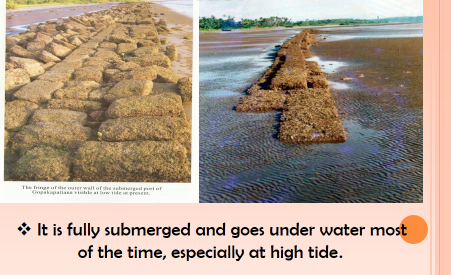
The outer wall of this five kilometres long stone-built port can still be seen at low tide on the banks of the River Zuari between Goa-Velha and Agasaim villages, situated around Pilar. The wall is submerged at several places and is also buried in the silt and sand and goes fully under water as the tide rises.
At the beginning of the 20thcentury the wall was strengthened with mortar and cement at a few places by the owners of the coconut grove around it, in order to avoid the water gushing in at high tide.
- PILAR MONASTERY
After the Portuguese conquest of Goa, the above mentioned hillock came to be known as Pilar because of the devotion to Our Lady of Pilar, introduced by the religious contemplative branch of the Franciscans, called Capuchos (Capuchins, Reformed Recollects), who built on it the Pilar Monastery in 1613 AD, and occupied it till the suppression of all religious orders by the Portuguese Government in 1835.
After that the Pilar Monastery was confiscated, abandoned and came to be used as a stable for cows, by those appointed as caretakers by the same Government.
From 1855, some Goan Carmelites, who also had previously been suppressed and expelled from their Monastery in Chimbel, were permitted by the
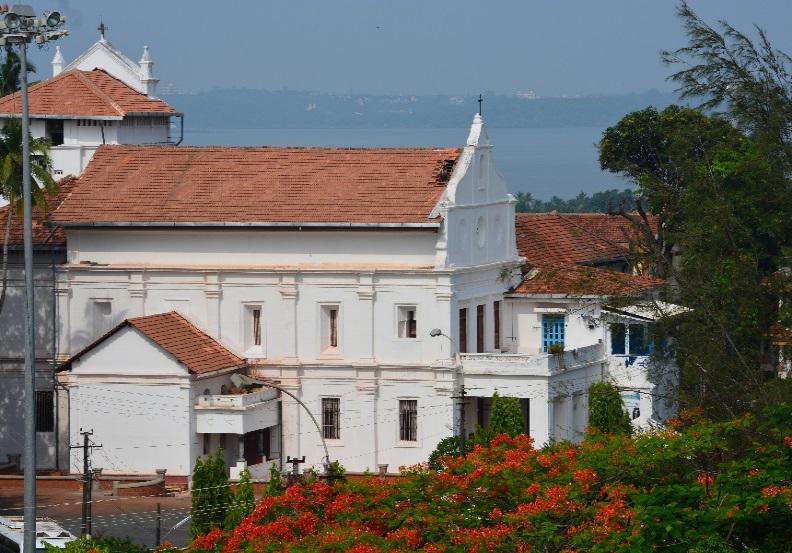
Figure 1 (d)) – Pilar Monastery today
Portuguese Government, to continue their religious practices. They occupied the Pilar Monastery till the death of the last Carmelite in 1887.
Meanwhile, it is said that the Portuguese Government had given orders to auction in public, the edifice of the Monastery with all its surroundings and hedges or to demolish the edifice and use the stones for laying the Agasaim –Panjim road, being planned at that time, which presently passes by the side of the hillock of Pilar 6. However, before the orders were put into execution, by the decree of 1878 from the Overseas Minister of Portugal, the Archbishop of Goa, D. Ayres d’Ornelas got the Pilar Monastery as his summer residence7.
In 1887, the Society of Missionaries of St Francis Xavier was founded at Agonda, in Canacona by Goan native priests. From 1890, the Archbishop of Goa gave the Pilar Monastery as the headquarters and mother house of this nascent Society and since then it came to be known as the Society of Pilar, an indigenous religious institute of Catholic Priests and Brothers, all Indian nationals. Ven. Fr Agnelo D’Souza was a saintly member of the Society who died as a Spiritual Director of the Seminary of Rachol on 20/11/1927, after serving in the Society for 30 years. Eleven years after his death, his bones were transferred on 10-1-1939 to Pilar Monastery, which since then became a centre of pilgrimage for thousands of his devotees. Six months later, on 2nd July 1939 the Society was re-organized and in 1942, the Society opened its own Seminary for recruitment and training of its future members, for which purpose the foundation for the spacious Pilar Seminary building was laid on the Pilar hillock on 2nd December 1946, and the constructionwent on slowly, until its final completion on 12th August 19628 (See figure 1a). It is, as said above, the venue of the Museum.

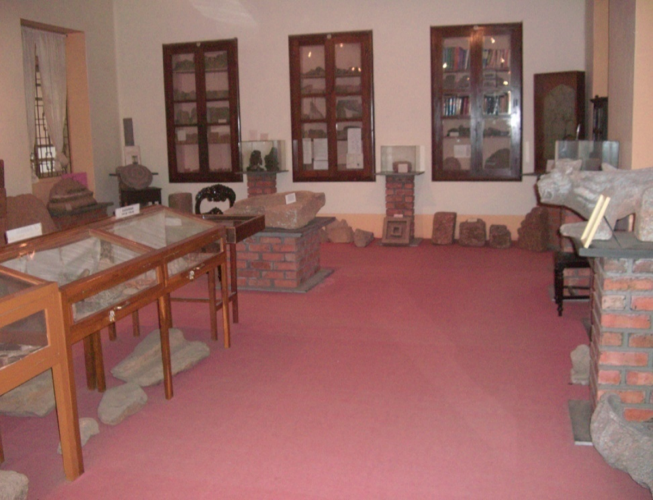
Figure 1 (e) – Views of the two sides of the Pilar Museum at the entrance of the Seminary before 2017 renovation
.
1 P.P. Shirodkar, then Director of Archives Archaeology and Museums, in an article: The Discovery of Gopakapattan, published in Goa Today, May 1991, pp 42-48.
2 Pattana means an ancient port e.g. Negapattana,Vijayagapattana.etc. Gopakapattana was a 5 kms long built port with huge stone buttresses on the banks of the river Zuari.
3 NIO scientist Rajiv Nigam, Remnants of India’s one of the ports found in Goa, front page news on Gomantak Times, Panaji 16th July 2015. Many newspapers reported this news on 17-7-2015.
4 A. R. S. Dhume, The Cultural History of Goa from 10,000 BC to 1352 AD, MAPP Printers, Panjim 1985, p 306.
5 K. A. Nilkanta Shastri, A History of South India from Pre- Historic Times to the Fall of Vijayanaga, pp16-17. Cf A.R.S. Dhume, op. cit. p 223
6Cfr. D. A. S. Valente, Officium, Livro de Portarias No 13 p 95, Paco Patriarchal, Panjim.
7 Lucio Vaz, O Convento do Pila e Mons. Lucio Vaz, p VII
8 C. J. Costa, Ven. Fr. Agnelo , An Ardent Pastor, Xaverian Publications, Pilar, 2016 pp12-14 & 72-75
